NASA Captures Active Volcano Erupting on Jupiter's Moon Io
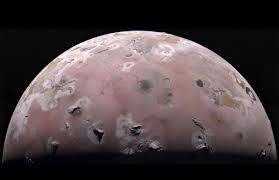
- 14 Dec 2024
In News:
NASA has revealed new details about Io, Jupiter’s third-largest moon and the most volcanic world in our solar system.
Overview:
- NASA’s Juno mission has revealed new insights about Io, Jupiter's third-largest moon, known as the most volcanic world in the solar system.
- Io has over 400 active volcanoes, which send plumes and lava flows into space, creating its unique, fiery surface.
Recent Discoveries and Observations:
- Fiery Heart of Io:
- NASA's Juno mission has helped solve a 44-year-old mystery regarding Io’s volcanic activity, revealing that its volcanoes are likely powered by separate magma chambers rather than a single large magma ocean.
- This discovery was made during Juno’s close flybys in late 2023 and early 2024, using Doppler measurements and precise gravity data to understand the moon’s interior.
- Volcanic Activity:
- Io's volcanoes constantly erupt, spewing lava and plumes that shape its surface. The volcanic activity was first observed by NASA's Voyager 1 spacecraft in 1979.
- Tidal Flexing: Io experiences constant squeezing due to its elliptical orbit around Jupiter, which generates immense internal heat and causes frequent eruptions.
- Scientific Insights:
- The research suggests that tidal forces from Jupiter do not create a global magma ocean inside Io, as previously thought, but instead lead to localized magma chambers that fuel its volcanoes.
- Tidal flexing is the primary cause of the immense internal energy on Io, which melts portions of the moon's interior and drives volcanic activity.
- Broader Implications:
- Understanding Other Moons and Exoplanets: Juno's findings have broader implications for understanding the interiors of other moons like Enceladus and Europa, and even exoplanets and super-Earths.
- Future Missions:
- Juno will continue its mission, with the next close approach to Jupiter scheduled for December 27, 2024, bringing it 2,175 miles above Jupiter's cloud tops. Since entering Jupiter’s orbit in 2016, Juno has traveled over 645 million miles.
Leber Congenital Amaurosis (LCA)

- 08 May 2024
Why is it in the News?
Scientists utilized a CRISPR-Cas9 tool to restore vision in individuals, including adults and children, afflicted with congenital blindness termed Leber congenital amaurosis (LCA).
What is Leber Congenital Amaurosis?
- Leber Congenital Amaurosis (LCA) is a rare genetic eye disorder where affected infants experience severe vision loss or blindness at birth.
- The condition results from the impaired function of light-gathering cells (rods and cones) in the retina.
Prevalence and Cause:
- LCA affects approximately one in 40,000 people.
- It is caused by a gene mutation that disrupts the proper function of the CEP290 protein, which is critical for vision.
Recent Development:
- Scientists have employed CRISPR-Cas9 gene editing technology to develop a novel therapy called EDIT-101.
- In a clinical trial called "BRILLIANCE," participants received a single dose of EDIT-101.
- The treatment involves cutting out the mutation in the CEP290 gene and replacing it with healthy DNA, restoring the normal function of the CEP290 protein and allowing the retina to detect light.
- This groundbreaking approach offers a promising treatment for individuals affected by LCA.
What is CRISPR-Cas9?
- CRISPR-Cas9 is a unique technology that enables geneticists and medical researchers to edit parts of the genome by removing, adding or altering sections of the DNA sequence.
- It is currently the simplest, most versatile and precise method of genetic manipulation.
How does CRISPR-Cas9 work?
- The CRISPR-Cas9 system operates through two primary molecules:
- Cas9, an enzyme often likened to "molecular scissors," which can precisely cut both strands of DNA at a designated location in the genome.
- Guide RNA (gRNA), a segment of RNA containing a specific pre-designed sequence (about 20 bases long) within a longer RNA scaffold.
- The scaffold binds to DNA, while the pre-designed sequence guides Cas9 to the intended genomic location, ensuring accurate DNA cleavage.
- The guide RNA is tailored to identify and bind to a particular sequence in the DNA, with RNA bases that complement those of the target DNA sequence.
- This specificity ensures that the guide RNA binds solely to the target sequence and avoids other genomic regions.
- Once bound, Cas9 cuts across both DNA strands at the targeted location.
- Subsequently, the cell's repair mechanisms recognize the DNA damage and attempt to rectify it.
- Scientists exploit this DNA repair process to introduce alterations to one or more genes within the genome of a selected cell.
Mount Ruang
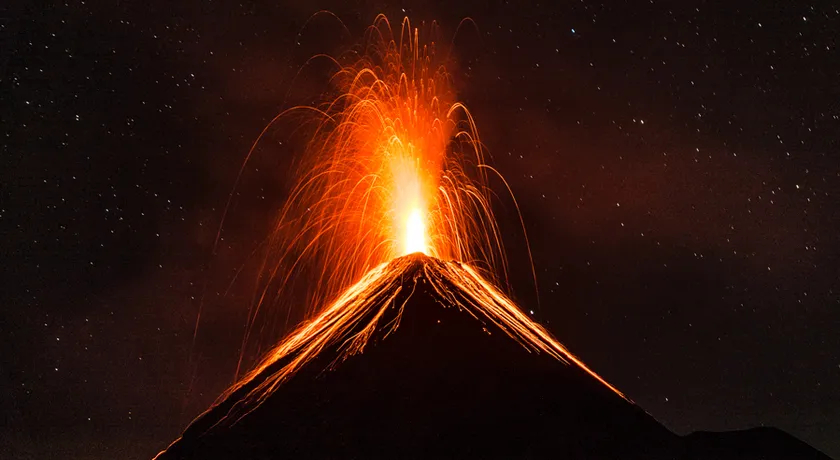
- 19 Apr 2024
Why is it in the News?
A remote volcano in Indonesia’s outermost region erupted again on April 19 after the crater threw up columns of smoke and lava multiple times this week and forced thousands to evacuate.
About Mount Ruang:
- Mount Ruang is an active stratovolcano located in the Sangihe Islands arc, North Sulawesi, Indonesia.
- It is the southernmost volcano in the region, situated on an island that measures 4 by 5 kilometers wide.
- The summit features a partial lava dome and reaches an altitude of 725 meters.
- Mount Ruang has experienced multiple eruptions throughout its history, with the most recent ongoing eruption starting on April 18, 2024.
- The volcano's eruptions often generate ash columns, lava flows, and gas emissions, posing risks to nearby communities.
What is a Stratovolcano?
- A stratovolcano is a tall volcano shaped like a cone, formed by various layers of materials such as volcanic ash, hardened lava, pumice, and tephra.
- Stratovolcanoes are steep and have periodic explosive and effusive eruptions, although some have calderas, which are collapsed craters.
- The highly viscous lava that flows from this type of volcano cools and hardens and in turn, does not spread far.
- The magma that forms this lava is generally felsic.
- Stratovolcanoes are more common than shield volcanoes.
- One of the famous stratovolcanoes is Vesuvius which destroyed Herculaneum and Pompeii in 79 CE.
Formation Of Stratovolcanoes:
- Stratovolcanoes occur mostly in subduction zones, where the oceanic crust slides under continental crust.
- The descent of the oceanic plate causes the release of trapped water from hydrated minerals and porous rock, into the mantle rock in the area above the oceanic slab.
- This process occurs at different pressures depending on the minerals.
- The water lowers the mantle rock’s melting point, causing partial melting and its rise to the lithosphere forming a temporary pool.
- The magma then continues to rise through the crust collecting rock rich in silica.
- The magma finally pools in the magma chamber which is either within or under the volcano.
- The low pressure at this point causes the volatile compounds such as water, carbon dioxide, and sulfur dioxide dissolved in the magma to escape.
- When the magma and gas accumulate to a critical level, they overcome the rock blockage of the volcanic cone and erupt violently.
Volcanic Vortex Rings
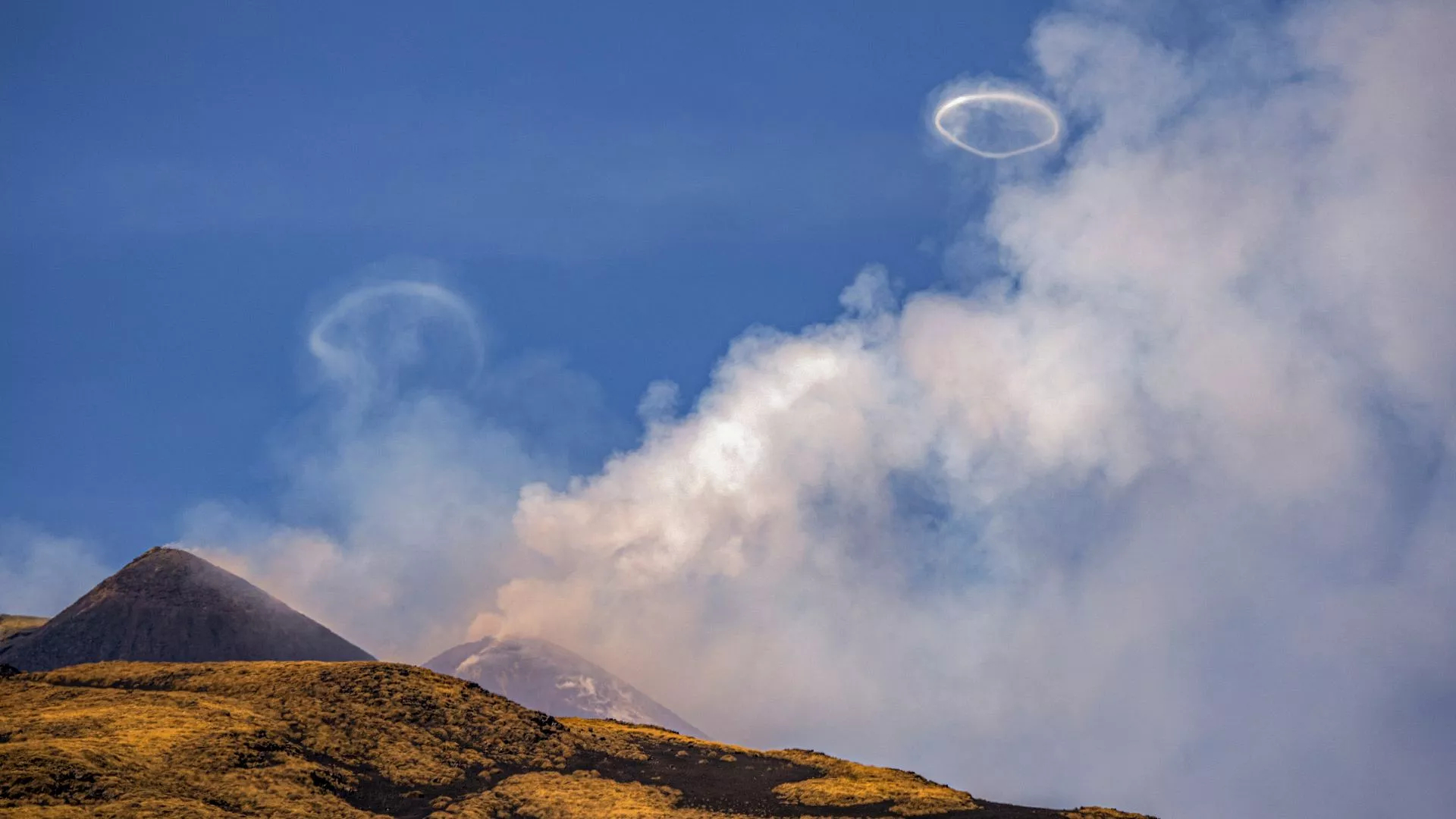
- 12 Apr 2024
Why is it in the News?
Since last week, Mount Etna has been sending up almost perfect rings of smoke into the air which are a rare phenomenon that scientists refer to as volcanic vortex rings.
What are Volcanic Vortex Rings?
- Vortex rings are generated when gas, predominantly water vapor, is released rapidly through a vent in the crater.
- The vent that has opened up in the crater is almost perfectly circular so the rings.
- The phenomenon was first observed at Mt. Etna and Mt. Vesuvius in Italy in 1724 and has been documented in an engraved plate from 1755.
- In more recent times, volcanic vortex rings have been observed at volcanoes such as Redoubt in Alaska, Tungurahua in Ecuador, Pacaya in Guatemala, Eyjafjallajökull and Hekla in Iceland, Stromboli in Italy, Sakurajima in Japan, Yasur in Vanuatu, Whakaari in New Zealand, and Momotombo in Nicaragua.
- According to the report, the rings can remain in the air for up to 10 minutes but tend to disintegrate quickly if conditions are windy and turbulent.
About Mount Etna:
- Mount Etna, sometimes referred to simply as Etna, is an active volcano on the east coast of Sicily, the largest island in the Mediterranean Sea, lying just off the toe of the Italian “boot”.
- Etna’s peak is the highest in Italy south of the Alps, and it is Europe’s largest and one of the most active volcanoes.
- Etna’s summit has five craters, which are responsible for most of the volcano’s eruptions; there are also “flank” eruptions that occur out of 300-odd vents of varying sizes along the slopes of the mountain.
- Etna is in almost constant activity and has seen, since the year 1600, at least 60 flank eruptions and many more summit eruptions.
- In recent years, summit eruptions have occurred in 2006, 2007-08, on two occasions in 2012, 2018, and 2021; flank eruptions have taken place in 2001, 2002-03, 2004-05, and 2008-09.
- Etna has been a World Heritage Site since 2013, and according to UNESCO, the volcano’s eruptive history can be traced back 500,000 years.
- At least 2,700 years of this activity have been documented.
NASA Recently Shared a Satellite Image of Deception Island (Tribune India)
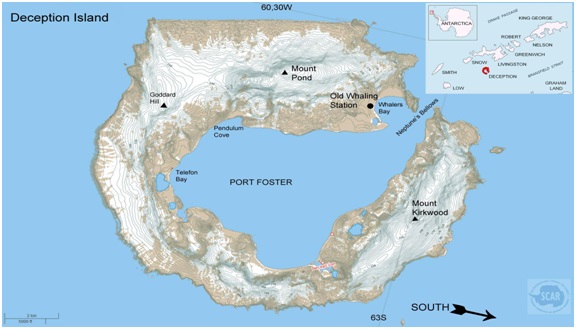
- 11 Oct 2023
Why in the News?
National Aeronautics and Space Administration (NASA) recently shared a satellite image of Deception Island, one of the only places in the world where a ship can sail directly into the centre of an active volcano.
About Deception Island:
- Deception Island is situated within the South Shetland Islands, forming part of an archipelago northwest of the Antarctic Peninsula.
- This volcanic island is notable for its dynamic features and distinct geography.
- Originating from a colossal volcanic eruption, Deception Island's formation resulted in the collapse of its central structure, allowing seawater to inundate the resulting caldera.
- The landscape is characterized by desolate volcanic slopes, steaming beaches, and glaciers adorned with ash layers, creating a unique horseshoe-shaped entrance to the sea via Neptune’s Bellows.
- The island encircles Port Foster, recognized as one of the safest harbours in the Antarctic, offering vessels a rare opportunity to navigate into the heart of an active volcano.
- Among the few places globally where this is possible, Deception Island has experienced over twenty eruptions since the 19th century.
- Notably, the island witnessed three volcanic eruptions from 1967 to 1970, leading to the destruction of Chilean and British stations.
- Presently, Argentina and Spain maintain summer scientific stations on the island.
- Deception Island is safeguarded under the Antarctic Treaty, designating it as a protected area with restricted human visits and minimized environmental impact.
Phreatomagmatic Eruptions (TOI)
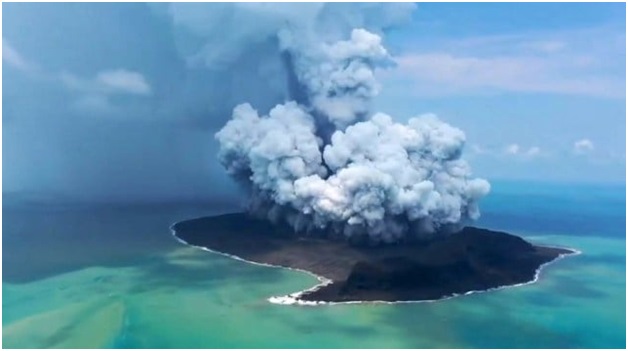
- 11 Nov 2023
Why in the News?
Recently a new island emerged near Japan's Ogasawara island chain after an undersea volcano erupted.
What is Phreatomagmatic Eruption?
- A phreatomagmatic eruption is a volcanic eruption caused by the interaction of magma and water.
- They differ exclusively from magmatic and phreatic eruptions.
- Unlike phreatic eruptions, the products of phreatomagmatic eruptions contain juvenile (magmatic) debris.
- Large explosive eruptions typically contain magmatic and phreatomagmatic components.
- Phreatomagmatic ash is formed by the same mechanism over a wide range of basic and acidic compositions.
- A blocky and uniform crust with low vesicle content is formed.
- Deposits from phreatomagmatic eruptions are thought to be better classified and finer-grained than those from magmatic eruptions.
- This is the result of higher fragmentation of phreatomagmatic eruptions.
About Ogasawara Islands:
- The Ogasawara Islands are a group of more than 30 small subtropical islands in the North-Western Pacific Ocean roughly 1,000 km south of the main Japanese Archipelago.
- It is also known as the Bonin Islands.
- It is one of the famous UNESCO World Heritage sites of Japan.
